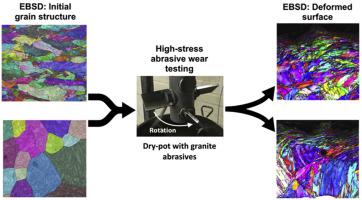Our official English website, www.x-mol.net, welcomes your
feedback! (Note: you will need to create a separate account there.)
Effect of prior austenite grain size on the abrasive wear resistance of ultra-high strength martensitic steels
Wear ( IF 5.3 ) Pub Date : 2020-08-01 , DOI: 10.1016/j.wear.2020.203336 Oskari Haiko , Vahid Javaheri , Kati Valtonen , Antti Kaijalainen , Jaakko Hannula , Jukka Kömi
Wear ( IF 5.3 ) Pub Date : 2020-08-01 , DOI: 10.1016/j.wear.2020.203336 Oskari Haiko , Vahid Javaheri , Kati Valtonen , Antti Kaijalainen , Jaakko Hannula , Jukka Kömi

|
Abstract Prior austenite grain size has a marked effect on the hardenability, strength, and impact toughness properties of steels. This study was conducted in order to understand the effect of prior austenite grain size and morphology on the mechanical properties and abrasive wear performance of an ultra-high strength steel. A commercial quenched 500 HB grade wear-resistant steel was selected for the study: the steel was austenitized at two different temperatures and compared to the original, as-received quenched condition. The resulting mean prior austenite grain size was ranging from 14 μm to 34 μm. The decrease in grain size improved the low-temperature impact toughness properties. A high stress abrasive wear testing method with natural granite abrasives was utilized for the evaluation of abrasive wear resistance. The results suggest that decreasing the prior austenite grain size improves the abrasive wear resistance with similar hardness level martensitic steels. In addition, high-resolution electron backscatter diffraction measurements revealed formation of ultra-fine grain structures in the severely deformed regions of the wear surfaces.
中文翻译:

原奥氏体晶粒尺寸对超高强度马氏体钢耐磨性的影响
摘要 原奥氏体晶粒尺寸对钢的淬透性、强度和冲击韧性有显着影响。本研究旨在了解原始奥氏体晶粒尺寸和形态对超高强度钢的机械性能和磨粒磨损性能的影响。研究选择了一种商用淬火 500 HB 级耐磨钢:该钢在两种不同的温度下进行奥氏体化,并与原始的、收到的淬火条件进行比较。所得的平均原始奥氏体晶粒尺寸范围为 14 μm 至 34 μm。晶粒尺寸的减小提高了低温冲击韧性性能。使用天然花岗岩磨料的高应力磨料磨损测试方法来评估耐磨性。结果表明,与类似硬度水平的马氏体钢一样,降低原奥氏体晶粒尺寸可提高耐磨性。此外,高分辨率电子背散射衍射测量表明在磨损表面的严重变形区域形成了超细晶粒结构。
更新日期:2020-08-01
中文翻译:

原奥氏体晶粒尺寸对超高强度马氏体钢耐磨性的影响
摘要 原奥氏体晶粒尺寸对钢的淬透性、强度和冲击韧性有显着影响。本研究旨在了解原始奥氏体晶粒尺寸和形态对超高强度钢的机械性能和磨粒磨损性能的影响。研究选择了一种商用淬火 500 HB 级耐磨钢:该钢在两种不同的温度下进行奥氏体化,并与原始的、收到的淬火条件进行比较。所得的平均原始奥氏体晶粒尺寸范围为 14 μm 至 34 μm。晶粒尺寸的减小提高了低温冲击韧性性能。使用天然花岗岩磨料的高应力磨料磨损测试方法来评估耐磨性。结果表明,与类似硬度水平的马氏体钢一样,降低原奥氏体晶粒尺寸可提高耐磨性。此外,高分辨率电子背散射衍射测量表明在磨损表面的严重变形区域形成了超细晶粒结构。











































 京公网安备 11010802027423号
京公网安备 11010802027423号